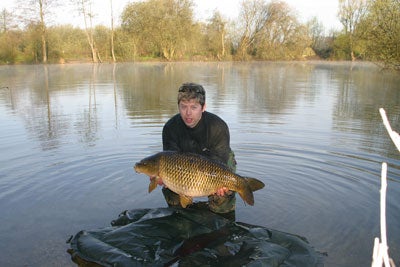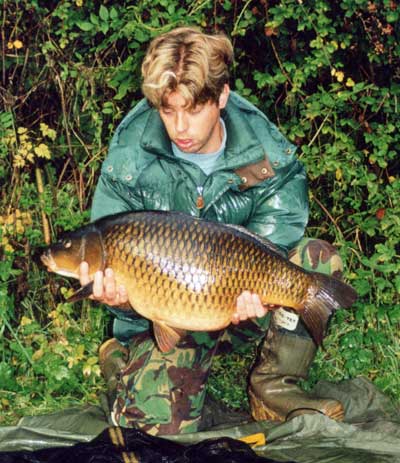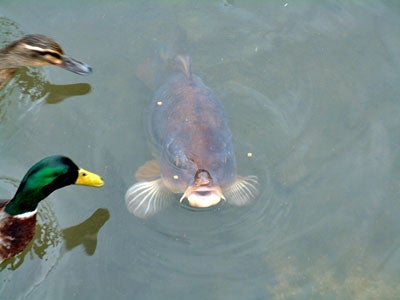WatercraftTHIS IS PROBABLY the hardest one to write, as watercraft can’t really be learned. There are some people, like Rod Hutchinson, that just seem to know where the fish will be, and can be there before they arrive. Most of the truly ‘great’ anglers are like this. On the other hand, there are the anglers (like me) who have to work at it, using your experiences and a bit of logic to try and work it out – so I’ll try and give you a few pointers.
We should all walk around lakes before we fish, looking for jumping fish or coloured water, but realistically it isn’t always possible on today’s fisheries – you just have to try and get as close as possible. I’m always a bit wary of leaping carp, where they clear the water, as I’ve found they are rarely feeding carp. You might sometimes get a take from a bait cast bang on the spot they are showing, but I think that’s more from the curiosity factor. Fish holding spots Snags, reeds or weed beds will almost always hold fish, so if you are struggling check these areas first. Chances are though – everyone else will have as well! Islands and other visible features like fallen trees all attract fish, but they also attract anglers, so fish learn not to visit them, or at least be very careful around those areas. Remember that some of the bigger fish could’ve been dodging anglers for 20 years or more in some of these areas. Carp that are ‘porpoising’ or rolling on the surface are another thing though. They are normally feeding fish, and perhaps the only time I’ve had problems is when they’ve been hitting a fly hatch just below the surface as it can be hard to tell the difference – though a small boilie or a small piece of black foam fished Zig Rig style can sometimes bring a result. The ideal is to find some coloured up water, with bits of twigs, old leaves and weed floating up, as it’s where the fish are feeding hard – normally the easiest carp to catch as they are already feeding. Look for things like twitching reed stems or lily pads. Carp are large fish and will move things as they swim through the water. Do a bit of twitching! Birdlife can be useful – it’s fairly well documented that the ducks on Horseshoe used to follow the shoals of carp around, often you would be sitting there runless, then the ducks would drift over your bait and the runs would start!
Carp can easily panic coots, you sometimes see them dive, and then come flying back up screaming – something down there has scared them. You also see ducks and coots paddling along, and then suddenly stop, staring down at the water, and slowly back off. Chances are it’s either a carp or a pike. Before daylight and after dark On some waters, the fish rarely show during the day, so it’s worth getting there just before first light or staying just after dusk, as they can show themselves at these times. I did fish a water where I can honestly say the only fish I saw were either found in the edge feeding, or found in the edge in my landing net. I never saw a fish jump in two years! In these cases you have to look for the subtle things – like flatspots or debris floating up, or try and use the weather. Keep an eye on the wind and the weather Weather plays a huge part in the carp’s behaviour. Even where angling pressure has ‘taught’ fish not to act naturally, ie, when they won’t always follow the wind, you can be sure that they will probably be on the back of the wind, so they are predictably unpredictable! Saying that, in summer, whatever the weather, I will nearly always move onto a new wind, as that’s where the food goes, plus the water will be a bit more oxygenated and the carp will normally follow. In winter it can depend on the wind direction. An easterly wind is probably the coldest one, and normally is associated with high air pressure. This can make the fish sit high in the water, so Zigs can be the way forward. I’d tend to stay away from the west bank, as this is where the cold wind blows to. Northerly winds can actually be quite good, as you usually get them as a warm low pressure moves across the country – the air having originated in the Atlantic. It’s always worth looking to see where the weather has come from, sites like Metcheck will hold data going back a few days which will help. The text book bank to fish in winter is the north east one, as the warmer south westerlies blow onto it, though I’ve found if the weather is a bit all over the place, the fish can seem to hold up in the middle of the lake – it’s almost as if they don’t want to keep moving around, so the middle is a ‘neutral’ area. On bright sunny days, the fish can be found in quite shallow water, as it will be slightly warmer than the surrounding areas, so its worth a look. Consider angling pressure Angling pressure is always worth taking into consideration – there might be the nicest, biggest, snaggiest bay that a warm fresh breeze is blowing into that no one’s fishing, but the guy who has got his rods spaced out across the mouth of the bay with tight lines could deter the fish from moving into it. Likewise, someone might have caught a couple of fish and next thing you know, leads are landing all around them, spodding, baits being catapulted out – probably best to find a nice quiet corner! Those perfect looking text book snags and islands look good to everyone, so you can guarantee they are heavily pressured – fish might still visit, but will rarely get caught from there. Its often much better to land some way short. One of ‘my’ lakes has an island like this, and despite myself I always put a bait on it (it’s rude not to!)…. well, at least until I found a tiny bar that ran off the end of it. More like a little hump, but the fish fed off the back of it. Hotspots There are two types of hotspots, natural and manmade ones. Natural ones are the ones we’ve talked about, like islands and snags, but the best ones are those where there are areas of natural food, such as bloodworm and mussel beds. Weedbeds will also contain masses of naturals, with the only downside being that the fish can be preoccupied on the naturals, making it hard to get a take on normal baits. You can find them by watching to see if fish constantly show in the same spot; look for fly hatches. If you think you have found one, it’s worth casting a rig out with a treble hook on it and drag it through. Often you will pull bloodworm back in, the red, juicy ones that mean the spot is still prime. Thin grey ones often mean the spot has been stripped, but you can guarantee the fish will keep checking it. Make your own hotspot The other type you can create yourself by constantly baiting a spot. It also happens unplanned on some lakes. You might have a completely barren bar with a twig sticking out of the water. People will naturally start fishing to the twig, and baiting up around it. One or two fish get caught, so the swim becomes a popular one, and more bait goes in – creating a ‘natural’ feeding area. They won’t be as easy to catch from as a natural one though. But you have to remember carp aren’t machines – you can apply all these things to unpressured carp and you will probably find them. Apply it to pressured fish, and you have a fair chance of finding them, but if they want to be in a certain place at a certain time, they will ignore everything else and go there. So keep your eyes open! If you are fishing a water for a fair amount of time, make a note of where fish are in certain conditions, or at certain times. Often a pattern will emerge which can make things far easier in the long run. Next in Part 6 – Bait |
Welcome!Log into your account













